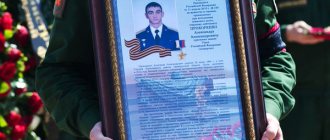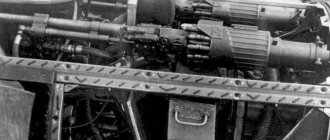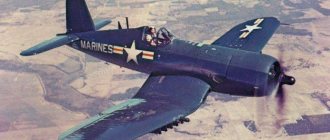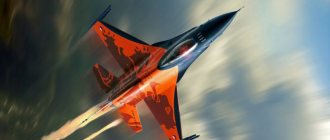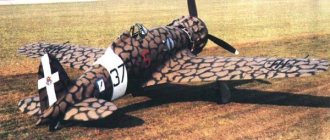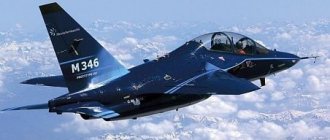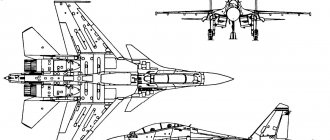Features of the Su-30 fighter and its technical characteristics
The Su-30 combat fighter is a two-seat variation of the Su-27 and has the technical capabilities to perform complex flights with long duration and range. The crew of such a machine consists of a pilot who pilots and controls close-combat weapons, and a pilot-operator who solves issues of navigation and monitoring the air situation in long-range combat. In addition, the second crew member controls long-range radar detection systems to guide them to targets, and also has the ability to control group combat operations of aircraft units, numbering up to 4 aircraft.
The Su-30 has new equipment systems installed that significantly expand its technical capabilities and characteristics. These include:
- an in-flight refueling system equipped with a retractable boom located in the compartment in front of the cockpit;
- long-range navigation and guidance radio system;
- wide-screen television indicator of the tactical situation for coordinating group actions;
- improved life support system.
The high combat effectiveness of the Su-30 is determined by its high maneuverability characteristics in all weather conditions, the ability to detect air targets at long range, as well as its individual performance characteristics:
- wingspan - 14.7 m;
- length/height – 21.94 m/6.36 m;
- normal/maximum take-off weight, kg – 18800/33000;
- flight range, km with one refueling/without refueling – 5200/3500;
- lifting speed – 330 m/s;
- practical lift ceiling – 19500 m.
Today, the super maneuverable Su-30 fighter is one of the main export products of the Russian military-industrial complex. India (they plan to purchase 126 modified Su-30 aircraft in 2022), Venezuela, Angola, Algeria, Iraq (as of the beginning of 2022 have received 5 aircraft), and China are showing attention to the fighter.
Development[edit]
Su-30MKM at LIMA
In August 2003, Malaysia signed a contract worth US$900 million with Irkut Corporation for the supply of 18 Su-30MKM. Malaysia operates eight legacy F/A-18D Hornets, and was offered the Boeing F/A-18E/F Super Hornet, but the Royal Malaysian Air Force chose the Su-30MKM instead. The Su-30MKM is an improved variant, with significantly improved characteristics compared to the Su-30MK/MKK. [3] Irkut Corporation subcontracted the task of manufacturing canards, stabilizers and fins to Hindustan Aeronautics Limited. As part of the contract agreement, Russia sent the first Malaysian astronaut to the International Space Station. This was a project initiated under an interstate offset agreement through the purchase of Su-30MKM fighter aircraft for the Royal Malaysian Air Force. Under this agreement, the Russian Federation assumed the costs of training two Malaysians for spaceflight and sending one to the International Space Station (ISS) in October 2007 under the Angkasawan program. [4]
The first two aircraft were transferred to the RMAF in May 2007 at the aviation facility in Irkutsk, Russia. The two aircraft were later delivered to RMAF Gong Kedak, Malaysia in June 2007 by an Antonov 124-100 transport aircraft. By December 2007, seven months after the delivery of the first two aircraft, the Russian Air Force had received six Su-30MKMs. The eighteenth and final aircraft arrived at RMAF Gong Kedak in August 2009.[5]
In 2016, a Su-30MKM successfully dropped a Paveway II laser-guided bomb in a gunnery exercise. The aircraft, registered M52-08, successfully dropped bombs at the Kota Belud test site in Sabah on November 27, 2016.[6]
Su-30 assembly parts
The new Su-30 fighter has an integral layout and is designed according to a normal aerodynamic design. The fuselage is integrally coupled with the wing and consists of the following main parts:
- the head part is made as an all-metal semi-monocoque, where the avionics, radar, niche door of the front landing gear, radio-transparent fairing and cockpit canopy are located;
- the middle part with the main load-bearing power unit of the aircraft - the center section, made in the form of a fuel tank-compartment, with a garrot power unit, the technical capabilities of which allow the installation of equipment and communication lines, doors of the main landing gear, and a brake flap;
- the tail section with two engine power nacelles, tail booms, a central fuselage boom, which includes a rear fuel tank compartment, a central equipment compartment, the end of the central boom with side fins and a container with drag parachutes;
- adjustable air intakes are located under the overflow of the wings and are equipped with a special release mesh that prevents foreign objects from entering the engines during takeoff and landing.
The trapezoidal mid-wing is made of three-spars and has a caisson structure. Its mechanization consists of deflectable flaperons with an area of 4.9 m2 with aileron and flap functions, as well as deflectable adaptive two-section noses with an area of 4.6 m2. Deflections of the toes and release of flaperons are carried out during takeoff and landing modes, or during maneuvering, when the indicated speed is up to 860 km/h. The detachable wing consoles have a sweep angle of 42°.
The retractable landing gear has a reinforced design to accommodate a large takeoff and landing weight. It is made with three supports, and its main supports are single-wheeled, the bow one is two-wheeled.
The pilot's double cabin of the Su-30 is made according to the “tandem” configuration for two pilots and is divided into two parts, rear and front. Both parts of the cabin are completely sealed and share a special two-section teardrop-shaped canopy with a large glass area and a movable segment.
The front cockpit is equipped with multifunctional liquid crystal displays with indicators displaying targeting and navigation information and control panels against the background of the windshield. The steering control lever has target designation and trim joysticks, a weapon selection switch with a shooting button on the reverse side.
In the rear cabin of the aircraft there is a team commander, whose seat is elevated relative to the front cabin, which provides good visibility in all directions for both crew members. There are also duplicate aircraft control levers and special guidance and communications equipment. The cockpit is equipped with a wide-format television indicator of the tactical situation, designed to collect all the necessary tactical information about the characteristics and coordinates of the movement of targets and the location in the air of interceptors in the group.
Links[edit]
- ^ abcd "Archive copy". Archived from the original on 2008-03-07. Retrieved March 7, 2008. CS1 maint: discouraged parameter (link) CS1 maint: archived copy as title (link)
- ^ abcd "Will Malaysia's Su-30MKM bring more results?" . Retrieved April 4, 2022. CS1 maint: discouraged parameter (link)
- "NBC News - Latest News and Top Stories - Latest World, US and Local News". Retrieved April 4, 2018. CS1 maint: discouraged parameter (link)
- https://www.angkasa.gov.my/index.php?option=com_content&task=view&id=190&Itemid=258
- Hillebrand, Niels. "MILAVIA Aircraft - Su-27 Land Operators". www.milavia.net
. Retrieved April 4, 2022. CS1 maint: discouraged parameter (link) - https://www.defensenews.com/air/2017/06/15/malaysia-adapts-russian-built-jets-to-drop-us-made-bombs/
- "Archive copy" (PDF). Archived from the original (PDF) on December 09, 2014. Retrieved January 21, 2015. CS1 maint: discouraged parameter (link) CS1 maint: archived copy as title (link)
- "World Air Forces 2019". Flightglobal Insight. 2022. Retrieved March 2, 2022. CS1 maint: discouraged parameter (link)
- https://www.malaysiandefence.com/sukhoi-squadron-now-12th/
- ^ abcd Characteristics of the Su-30MK, Irkut, data received April 30, 2015 CS1 maint: discouraged parameter (link)
- ^ ab "Su-30MK characteristics page". Archived July 16, 2011, at the Sukhoi Wayback Machine.
Access date: January 1, 2015. - ↑
Hillebrand, Niels, "Sukhoi Su-27 Flanker Specifications",
milavia
, Niels Hillebrand, retrieved December 16, 2010. CS1 maint: discouraged parameter (link)
Su-30 engines
The power plant of the Su-30 fighter consists of two AL-31F twin-chamber turbojet engines, which provide it with a speed of 2350 km/h at high altitudes and 1350 km/h near the ground. The thrust value in afterburner mode is 12500 kgf, in maximum mode each is 7770 kgf. The engine has a modular configuration and consists of: a jet, supersonic nozzle and afterburner, a 9-stage high-pressure compressor, single-stage high and low pressure turbines, an annular combustion chamber, an external circuit, a 4-stage low-pressure compressor with an adjustable guide vane, an intermediate housing with central drive box.
Such engines have a characteristic feature - they are unique turbine blades with perfect operational and mechanical characteristics. They are equipped with an effective cooling system and are made of a heat-resistant monocrystalline alloy.
Su-37 engines can operate for 20-30 seconds in the so-called “oil starvation” mode (when, after the start of an inverted flight, the oil pressure drops to 0), under conditions of negative and near zero overloads. To improve the reliability of the oil supply for engine lubrication under such operating conditions, the design of the lubrication system oil tank and the oil system have been redesigned and improved. The new oil block in its design has a flexible oil intake, a negative overload compartment, a cyclone air and oil separator, and venting valves for the negative overload compartment.
Al-31F engines have an autonomous thrust vector control system. It runs on kerosene, which is taken from the engine fuel supply system and does not depend on the aircraft's hydraulic system.
The engines are located in separate engine nacelles, which allows them to avoid aerodynamic interference.
Design[edit]
Su-30MKM from behind
The Su-30MKM was developed by the Sukhoi Design Bureau based on the Su-30MKI. The MKM version differs from the MKI mainly in the composition of the onboard avionics. Thales is supplying the head-up display (HUD), NAVFLIR forward-facing IR navigation system and Damocles guidance module. The aircraft is equipped with a Missile Approach Warning Sensor (MAWS) and a Laser Warning Sensor (LWS) manufactured by Avitronics (South Africa). [1] It can carry up to 8,000 kg/17,650 lb of weapons and payload to a non-refueling range of 700 nautical miles. [2]
“The Su-30MKM can legitimately claim super-maneuverability through digital wire-line communications,” and the two thrust-vectoring Saturn AL-31FP engines “produce 27,500 pounds of thrust each with afterburners.” This gives them an advantage in close combat. dogfights, allowing the pilot to quickly point the aircraft at potential targets to attract them to the AA-11/R-73 Archer's wide infrared seeker cone, then launch and quickly change energy state and direction." [2]
Electronic warfare (EW) systems, phased array radars, and laser rangefinder optical location systems were produced by leading Russian manufacturers. At that time, RMAF officers formed the Su-30MKM design team, which was based in Moscow; the team was actively involved in the integration of all avionics systems. [1] The aircraft can perform SEAD missions when equipped with two KNIRTI SAP-518 jamming units and Kh-31P anti-radiation missiles. The KNIRTI SAP-518 covers NATO surface-to-air and air-to-air threats in the GJ bands. Equipped with a NIIP N011M.radar with a phased array antenna for long-range air combat, capable of tracking up to 15 targets and hitting 4 targets simultaneously. It can also be equipped with a Thales Damocles Laser Designation Pod (Thales) for precision ground attack. It has rear-view radar, HUD (Thales), NAVFLIR (Navigation Forward Looking Infra-red) (French). Missile Approach Warning System (MAWS) and Laser Warning Sensor (LWS) supplied by Saab Avitronics of South Africa. [7]
Features of the armament of the Su-30 fighter
The Su-30 aircraft can carry weapons consisting of missiles and cannon and small arms equipment. Small arms are installed in the influx of the right wing and are represented by a single-barrel rapid-fire GSh-301 cannon with a 30 mm caliber and 150 rounds of ammunition. The missile is based on AKU (aircraft ejection devices) and APU (aircraft launch devices).
Guided weapons consist of missiles of various modifications:
- medium-range air-to-air class R-27;
- with radar semi-active homing heads R-27R;
- with homing thermal heads R-27T;
- close combat with thermal heads R-73;
- increased flight range of the R-27ER or R-27ET.
Missile weapons can be suspended at 10 points, 4 of which are located under the wing consoles, 2 each are located under: tandem center sections, engine nacelles, and wingtips. The weight of the total combat load can be 8000 kg.
Today, Su-30 military fighters are produced by OJSC Irkut Corporation. It announced the production of 60 units of combat vehicles in 2022, some of which will be used to equip air bases in Crimea.
Video about SU-30
IYULNKER yaS-30ly2OPEDMYUGMYUVEM DK GYUBNEBYUMH TSNYAONDYARBU B BNGDSUE OSREL SMHVRNFEMKH OKHKNRKHPSELSHU H AEYAOKHKNRMSHU KERYUREKEMSHU YOOYUPYURNB SOPYUBKELSHLH PUYERYULH YAPEDMEI DUKEMNYA RH X AKKHFMETSN BNGDSMNTSN AN, ONPUFEMKH MYUDBNDMSHU KH MYUGELMSHU ZHEKEY BYAELKH BKHDYULKH BNNPSFEMKH, B OEPBSCH NVEPEDE BSHIANINRNVMSHL, OPH BEDEMHKH YUBRNMNLMSHU X TsPSOONBSHU DE IYARBHI B KCHASHU LERENSYAKNBHYU. YaYULNKER LNFER HYAONKEGNBUREYA DK NASVEMKH KERMNTSN YANYARYUBYU REUMKHYE OHKNRKHPNBUMHYE X OPHLEMEMHYUBKHYUZHNMMMSHU YAPEDYARB ONPUFEMEKH. MUKHVKHE BRNPNTSN VKEMYU SHYHOYUFYU YAMKHFUER MYUTSPSGYS MU KERVKHYU OPH BSHONKMEMHKH ANEBSHU GYUDYUMKHI I OPHLEMEMHEL SOPYUBKELNTSN NPSFKH ANKENNI DUKEMNYARKH, B MNVMSHU NOPEYUZHKH ЪU, YU RUYFE B OPNDNKFHREKEMSHU ONKERYU I DNGYUOPYUBYNI RNOKHBNL B BNGDSUE.
NYAMNBMSHLH NYNAEMMNYARLH YYULNKERYU YAS-30LY2 ЪБКЪЧРЯЪ:
- LNDKHTKHZHHPNBUMMYU YAKHYARELYU SOPYUBKEMKH BNNPSFEMHEL I PUYAHPEMMSHLH BNGLNFMNYARLH ON ONPYUFEMKHCH MUGELMSHU H LNPYAYKHU ZHEKEY;
- MNBYU YAKHYARELYU KHMDHYUZHHH B YYUAHME SHYHOYUFYU MU NYAMNBE ZBERMSHU LMNTsNTSMYZHNMYUKEMSHU FHDYNYPHYARYUKKHVEYAYKHU KHMDHYURNPNB;
- SKSVIEMMYU YAHYARELYU MYUBHTSYUZHHH PUDHNYABGHH;
- YANBPELEMMYU YOOYUPYURSPYU ANPRNBNTSN YNLOKEYAYU NANPNMSH;
- LKHPNYYU MNLEMYKURSPYU BNNPSFEMKH YKYUYAYANB "BNGDSU-BNGDSU" X "BNGDSU-ONBEPUMNYARE", PYUGLEYUELNTSN MU 12-RKH RNVYUU ONDBEYAYKH;
- YAHYARELYU DNGYUOPYUBYKH RNOXBNL B ONKERE;
- SYAKHKEMMYU YNMYARPSYZHKH OKYUMEPYU X YUYAYAH, NAEEAOEVKHBUCHYYU SHYYAOXYURYUZHCH YYULNKERYU I ONKMNI GYUOPYUBYNI RNOXBNL X LYYYAHLYUKEMNI ANEBNI MYUTSPSGYNI OPH BGKERMNI LYUYAYE DN 38 RNMM.
YAKHYARELYU SOPYUBKEMKH BNNPSFEMHEL YAYULNKERYU YAS-30LY2 NAEYAOEVKHBUER NAMYUPSFEMKHE, YANOPNBNFDEMKHE X SMKHVRNFEMKHE YUBHYUZHNMMSHLKH YAPEDYARBYULH ONPUFEMKH BNGDSMSHU, MUGELMSHU X LNPYAYKHU ZHEKEY B KCHASHU ONTSNDMSHU SYAKNBHYU DMEL X MNVECH.
nMYU BYKCHVIUER B YAEAJ DBE NYAMNBMSHE YAHYARELSH:
- YAKHYARELS SOPYUBKEMKH BNNPSFEMHEL YKYUYAYU "BNGDSU-BNGDSU", YANYARNYYSCH KH PUDHNKNYUZHNMMNTSN OPKHZHEKEMNTSN YNLOKEYAYU, NORKHYN-SHKEYRPNMMNI OPKHZHEKEMNI YAKHYARELSH YAHYARE LSH KHMDHYUZHHH MU TNME KNANBNTSN YAREIKYU.
- YAKHYARELS SOPYUBKEMKH BNNPSFEMHEL YKYUYAYU "BNGDSU-ONBEPUMNYARE", NAEYAOEVKHBUCHYSCH OPHLEMEMKHE UBNYNI MNLEMYKURSPSH BSHYANINRNVMNTsN NPSFKH DK ONPYUFEMKH MUGELMSHU ZHEK EI, YU RUYFE NRNAPYUFEMHE BYAYE OPHZHEKEMN-MYUBKHTSYUZHNMMNI HMTNPLYUZHHH MU 4-U LMNTSNTSMYZHNMYUKEMSHU KHMDHYURNPYUU, PUYAONKYUTSYUCHYCHYKHYUYU OPKHANPMSHU DAYYUU YUAKHMSH SHYHOYUFYU.
NYAMNBS KHMTNPLYUZHNMMN-SOPIUBKYETSN ONK YYUAKHMSH YAYULNKERYU YANYARYUBKCHR VERSHPE ZHBERMSHU LMNTsNTSMYZHNMYUKEMSHU KHMDHYURNPYU (lth), KHMDHYURNP MU TNME KNANBNTSN YAREIK YU (B OEPBNI YUAHME), MU YNRNPSHE B TSPYUTKHVEYAYNI KH ZHHTPNBNI TNPLE BSHBNDHRYA BEYAE MENAUNDHLSHI NAZEL OPKHZHEKEMN-OHKNRYUFMNI KH MYUBKHTSYUZHNMMNI KHMTNPLYUZHKH, YU RUYFE KHMTNPLYUZHKH N PUANRE ANPRNBSHU YAHYAREL YYULNKERYU. mYUPЪDS I LTH MU OPKHANPMSHU DAYYU YUAHMSH PYUGLEYUCHRYA KH RPYUDHZHNMMSHE SHCHKEIRPNLEYUMHVEYAYHE KHMDHYURNPSH, YNRNPSHL NRBNDYURNPSH B NYAMNBMNL DSAKHPSCHYKHE TSMY JXX.
pYUDKHNKNYUZHHNMMYU YARYUMZHKH (pkya) YAYULNKERYU YAS-30LY2 B PEFHLE “BNGDSU-BNGDSU” NAEYAOEVKHBUER: ONKHYAY BNGDSMSHU ZHEKEY; NONGMYUBYUMKHE TSNYASDYUPYARBEMMNI OPKHMYUDKEFMNYARKH NAMYUPSFEMMSHU ZHEKEY; YURYUYS ZHEKEY PUYERUL X LUKNI X YAPEDMEI DUKEMNYARKH I PUGKHVMSHLH YAHYARELYULH MYUBEDEMH; ONKHYAY, GUUBYUR X YANOPNBNFDEMKHE BHGSYUKEMN BHDHLNI ZHEKH B AKKHFMEL LYUMEBPEMMNL ANCH; B PEFHLE “BNGDSU-ONBEPUMNYARE”: BYAEONTsNDMNE NAMYUPSFEMKHE, KHGLEPEMKHE YNNPDHMYUR PUDHNYNMRPYYARMSHU MYUGELMSHU H MYUDBNDMSHU ZHEKEY; BSDHYUVS YNNPDHMYUR MUGELMSHU (MYUDBNDMSHU) JACKEYS DK NAYEOEVEMH OPHLEMEMH PUYER u-31yu, u-35sch, u-59ly.
NORKHYN-SCHKEIRPNMMYU OPKHZHEKEMYU YAKHYARELYU BYKCHVUER B YAEAJ NORKHYN-KNYUZHNMMSCH YARYUMZHCHCH X MYUKELMSCH YAKHYARELS ZHEKESYUGYUMKH. NORKHYN-KNYUZHNMMYU YARYUMZHH YYULNKERYU YAS-30LY2, OPEDYARYUBKQCHYYU YANANI YNLAKHMYUZHCH NAGNPMN-YAKEDYETSN REOKNOEKEMTSURNPYU H KYUGEPMNTSN DUKEMNLEPYU-ZHEKESYUGUREK Kommersant, HYAONKEGSERYA DK NAMYUPSFEMH X YANOPNBNFDEMH BNGDSSMNI ZHEKKH B OEPEDMEI X GYUDMEI EE ONKSYATEPUU HE REOKNBNLS HGKSVEMKHCH, KHGLEPEMKH DUKEMNYARKH KYUGEPMSHL KSVNL DN BNGDSSMNI X MUGELMNI ZHEKH, YU RUYFE LNFER OPHLEMREYA DK KYUGEPMNTSN ONDYABERYU MUGELMNI ZHEKKH OPH OPHLEMEMHH SOPYUBKELSHU PUYER YKYUYAYU "BNGDSU-ONBEPUMNYARE" I ONKSUYRKHBMNI KYUGEPMNI TSNKNBYNI YA YULNMYUBEDEMKH.
bNNPSPHEMHE YYULNKERYU YAS-30ly2 BYKCHVUER BYARPNEMMSCH YUBRNLYURHVEYAYSCH YAYNPNYARPEKEMSCH NDMNYARBNKEMSCH OSYS YUKHAPIU 30 LL RHOYU ts-301 I ANEYNLOCEYRNL 150 OYURPNMNB X P YYERMN-ANLANBNE BNNPSFEMHE, PYUGLEYUELNE MU 12 RNVIYUU ONDBEYAYKH OND YPSHKNL H TCHGEKFEL.
PUYERMNE BNNPSFEMKHE YKYUYAYU "BNGDSU-BNGDSU" BYKCHVIUER SOPYUBKELSHE PUYERSH YAPEDMEI DUKEMNYARH RHOYU p-27 - I REOKNBSHLH tsam (p-27r1, p-27schr1), I ONKSYURKHBMSHLH PYUDH NKNYUZHNMMSHLH tsam (p-27p1, p-27schp1), PUYERSH p-27o1, p-27scho1, Yu RUYFE PUYERSH AKKHFMETSN LYUMEBPEMMNTSN ANJ p-73sch Ya xy cyam X PUYERSH YAPEDMEI DUKEMNYARH pbb-yue I YURKHBMSHLH PUDHNKNYUZHNMMSHLH cyam.
dK ONPYuFEMKH MUGELMSHU (MYUDBNDMSHU) JACKEYS MU YAYULNKERE YAS-30LY2 HYAONKEGSERYA ANKEYU MNLEMYKURSPYU SOPYUBKELNTSN X MESOPYUBKELNTSN BNNPSFEMKH.
sOPYUBKELNE BNNPSFEMHE YKYUYAYU "BNGDSU-ONBEPUMNYARE" BYKCHVUER PUYERSH u-59lsch, u-35sch X u-59ly, BSHYANYNYAYNPNYARMSHE OPNRKHBNYNPYUAEKEMSHE PUYERSH YAPEDMEI DUKEMNYARKH y -31yu s YYURKHBMSHLH PYUDKHNKNYUZHNMMSHLH tsam X OPNRKHBNYUDHNKNYUZHNMMSHE PUYERSH YAPEDMEI DUKEMNYARH u-31o s OYYAYAHBMSHLH PUDHNKNYUZHNMMSHLH tsam, PUYERSH LUKNEY DUKEMN YARH u-29r (re) with REKEBHGHNMMSHLH XKH u-29k I KYUGEPMSHLH tsam, YNPPEIRKHPSELSCH YUBHYUANLAS yua-1500yP with REKEBHGHNMMNI tsam X YNPPEIRKHPSELSHE YUBHYUANLASH yua-500yP (yua-50 0-nd).
b YANYARYUB MESOPYUBKELNTSN BNNPSFEMKH BUNDYR YUBKHYUANLASH YUKHAPIU 500, 250 X 100 YTS, PYUGNBSHE ANLANBSHE YUYAYAYERSH, GUFHTSYUREKEMSHE AYUYH X MESOPYUBKELSHE PUYERSH I-8 , I-13, I-25-ntl.
yNMRPUYR MU ONYARYUBYS B yKHRYUI OEPBSHU 24 EDKHMHZH YAS-30li2 ASHK GUYKCHVEM B OMBUPE 2003 TsNDYU. oEPBYU OYUPRKH B YANYARYUBE 6 LYUHM NROPYUBKEMYU B TEBPYUKE 2004 TsNDYU. oKYUMKHPNBYUKNYAE, B REVEMKHE 2004 TSNDYu TSNDYU OEPEDYURE BYAE 24 YAYULNKERYU. b YANYARYUB BNNPSFEMKH SCHRKHU YNLOKEYANB BUNDIR OPNRKHBNNYNPYUAEKEMSHE PUYERSH YUBKHYUZHNMMNTSN AYUGHPNBYUMKH u-31yu. Yapyugs Onyak Okhokhyamkh Oepbnzn Ynmrpuyiry Ashkn Komn, Vrn Bemmn-Lnpyhahe Yakhksh Mnyui Mnui Tnplpnbumhel NDMNTSN ONKYYU PUYERNMNYAMNIA YUBHYUZHKH. yPNLE RNTSN, DK MUDEFMNI KHGNKJHHH REYURPYU BNGLNFMSHU BNEMMSHU DEYARBHI B PYYINME RYUIBYUM ONRPEASERYA ANKEE DUKEMNANIMNE PUYERMNE BNNPSPHEMHE.
brNPNTsN KhChM YUMTSKKHIYAYKHI EFEMEDEKEMKHY Jane's Defense Weekly YANNAYKHK N ONDTSNRNBYE BRNNTsN YNMRPYURYU MU ONYARYUBYS RUYNTSN FE YNKKHVEYARBU YAS-30LY2 I ANKEE LNYMNI oop u-59LSH I DUKE MNYARECH DEYARBHЪ 280 YHKNLERPNB. ONDOKHYUMKHE YNMRPUYURYU NFKHDUERYYY YaEMRAPCH 2004 TsNDYU, Y ONYARYUBYS ASDSR NYASYYYARBKRREYA OYUPRKHLH ON 12 EDKHMKhZh B 2005 X 2006 TsNDYUU. ONYARYUBYU BRNPNI OYUPRKHH YAS-30LY2 ASDER KHLERE YAKEDSCHYKHE YARPURETSKHVEYAYKHE KH BNEMMN-OPNLSHKEMMSHE ONYAKEDYARBKH:
- ymp OPNDNKFYUER NRMNYAHREKEMN ASHIARPSHLH RELOYULH MYUPYYHBYURE HLEMMN BNEMMN-LNPYAYHE BNNPSFEMKH, VRN YAN BYAEI NOPEDEKEMMNYARECH SYUGSHBUER MU BNGPUYURYUCHYCH BNEMMN-ONKHR KHVEYAYSCH GMYUVHLNYARE RYUIBYUMEYAYNI OPNAKELSH. ONUNFE, YHRYYYAYNE PSYNBNDYARBN ONYAREOOEMMN PYUGNVYUPNBSHBUERYA B YARPURETSKH LHPMNTSN BNYAYANEDHMEMKH I NYARPNBNL X MYUVHMYUER DEKURE YUZHEMR MU BNEMMSHU YAPEDYARBUU EYAKH ME OPKHYANEDKHMEMKH, RN UNR ASH SYARPUYEMKH YAOYUPYURKHYARNB. NAPYUYUER MU YAEA BMHLUMKHE, VRN Y 2006-2007 TsNDYUL imp ONKSVHR ZHEKSHY PJD LNPYAYHU YAHYAREL, B RNL VHYAKE BNYAELE DHGEKEMSHU KNDNY I PUYERMSHL BNNPSFEMHEL, DBY LNDEPMHGH PNBUMMSHU SHYALHMZHJU OP. 956schl I ANKEE LNYMSHLH SDYUPMSHLH PUYERMSHLH H GEMHRMSHLH YAPEDYARBYULH, X, MUINMEZH, B NAYYEI YAKNFMNYARH 48 LNPYAYKHU PUYERNMNYAZHEB YAS-30. ShchRKH YAKSH, ON BYAEI BKHDHLNYARKH, ASDSR EYE MEDNYARYURNVMSH DK OPNBEDEMKH SYAOEMNI YURYUYKH OPNRKHB RYUIBYUM, NDMYUYN KHLEMMN B OEPHND I 2006 ON 2008 TsNDSH OPEBNYAUNDYARB N YAEOYUPYURKHYARNB YARYUMER LHMHLYUKEMSHL H ASDER NAEYAOEVHBYUREYA B NYAMNBMNL GYU YAVER ANKEE YANBEPEMMSHU HMTNPLYUZHNMMSHU YAPEDYARB;
- yuuy "YASUNI" X HER NYAMNBMYU OPNLSHKEMMYU OKNYYUDYU √ yMyuyuon √ ONKSVYUCHR TSYUPYUMRKHPNBYUMMSCH GYUTSPSGYS EY MU DBYU TSNDU X ONVRKH BSHPYUBMHBUCHRYA ON SHRNLS ONY YUGYUREKCH I am my “xPYSR”, ONYARYUBNVMSHE YNMRPUYRSH YNRNPNI GYUYUMVKHBUCHRYA B 2007 TsNDS I OEPEDYUVEI BRNNTsN RPUMYU YAS-30lil B LYUKUIGHCH. b JANVERYUMXX I BNGLNFMSHLH MNBSHHLH KHMDNMEGHHIYAYHLH X BEERMYULAYHLH GYUYUGYULH YHRYUYYYHI YNMRPYYUR MU BRNPSCH OYUPRHCH YAS-30LY2 NAEYAOEVHR yuuy NAZELSH, YANONYARYUBHLSHHE I BSH PSVYNI “xPYSRYU”, DUFE I VERNLE ANKEKHU NAZELNB PYUANR, BSHONKMYELSHU ONYAKEDMHL ON KKHZHEMGKHNMMNLS YNMRPUYRS. RYUHL NAPUGNL, MH NDMYU HG YNMYSPHPSCYKHU YNLOYUMKHI ME ASDER KHLER B AKKHFUYKHE DBYU-RPH TSNDU BSHPUFEMMNTSN OPEHLSYYARBU ON YPHREPHCH BSHPSVIKH.
cru:
| lNDHTHYUZHH | yaS-30ly2 |
| pYUGLUU YPSHKYU, L | 14.70 |
| dKKHMYU YAYULNKERYU, L | 21.90 |
| bSHYANRYU YAYULNKERYU, L | 6.40 |
| OKNYYUDE YPSHKYU, L2 | 62.00 |
| I love it | |
| MNPLYUKEMYU BGKERMYU | 24900 |
| LYUYAHLYUKEMYU BGKERMYU | 34500 |
| I love RNOXBY, JC | |
| MNPLYUKEMYU | 5270 |
| LYUYAHLYUKEMYU | 9720 |
| dBHTSUREKH | 2 rpddt yuk-31t |
| rtsyu, ytsya | 2 U 12500 |
| LYUYAKHLYUKEMYU YAYNPNYARE, YL/V | |
| MU BSHIANRE | 2100 (l=2.0) |
| WITH GELKH | 1400 |
| oPUYRHVEYAYU DUKEMNYARE, YL | |
| AEG DNGYUOPYUBYKH | 3000 |
| I NDMNI DNGYUOPYUBYNI B BNGDSUE | 5600 |
| oPUYIRKHVEYAYKHI ONRNNKNY, L | 17300 |
| lyuYa. SHYYAOXYURYUZHNMMMYU OEPETSPSGYU | 9 |
| schYHOYUF | 2 |
| bNNPSPHEMHE: | 30-LL OSYa ts-301 I ANEGYUOYUYANL 150 BSHYARPEKNB, SYARYUMNBKEMNI YAOPYUBYU B MYOOKSHBE YPSHKYU. mu 12 OKHKNMNB ONDBEKHBUERYA 8000 YTS ANEBNI MYUTSPSGYKH (OPH ShchRNL YUFDSHI NRDEKEMSHI OKHKNM LNFER APYURE DN 1500 YTS.) b E╦ YANYARYUB BUNDIR: DN 6 sp YKYUYAYU ⌠BNGDSU-BNGDSU■ RKhonB p-27p/schp/, p-73sch X p- 77 (pbb-yue) HKKH 2 p-27o (scho), p-27r1 (schr1) DN 6 sp YKYUYAYU ⌠BNGDSU-ONBEPUMNYARE■ RHONB u-29r/k, u-25lk, u-25kd, u-31yu/o X i-25k; HKH 2 joint venture u-59lsch 6 YUBKHYUANLA yua-500yp, yua-500nd HKH 3 yua-1500yp, yua-1500k YABNANDMNOYUDYUCHIKHE YUBHYUANLASH YUKHAPNB NR 100 DN 500 YC; 8 ANLANBSHU YUYAYAER pai-500 Soashch-d; DN 8 GUFKHTSUREKEMSHU AYUNB ha-500 or mspya i-8, i-13 X i-25. oPEDSYALNRPEMYU RUYFE ONDBEYAYU YNMREIMEPNB I YOOOOYUPYURSPNI pscho, KYUGEPMSHLH DUKEMNLEPMN -ZHEKESYUGYUREKEMSHLH YAHYARELYULH, hy-YARYUMZHKHLH. |
| bottom. KhMTNPLYUZHKH: |
| tNRNCPYUTHH: | YaS-30ly2 (c) LYYYAHL aPMYAYKHI |
| YaS-30ly2 (c) Rosoboronexport | |
| YaS-30li2 bbya yKhryu | |
| YaS-30ly2 bbya beermulyu (c) manhhai | |
| YaS-30li2 bbya yKhryu | |
| YaS-30ly2 bbya bemkhyasshchksh (c) Resa Wahyu Giang | |
| YaS-30ly2 (c) Nick Shtremel | |
| yYUAHMYU OHKNRYU YaS-30ly2 (c) YuMDPEI mEVYUEB |
IWELSH:
| YaUELYU BYUPHYUMRNB BNNPSFEMKH |
| YaOHYANY HYARNVMKHYNB: |
| yMyuyuon. dBSULEYARMSHI LMNTsNZHEKEBNI HYARPEAHREKE YAS-30li2 pNYANNPNMSCHYAONPR. YaS-30li2 shYYAONPR bNNPSFEMKHI. ynMYARYMRKHM LUYCHEMIN. YAKHARELYU B LYUE - KHCHME 2004 TsNDYu Military.China.com Russianplanes.net. YaSUNI YaS-30ly2 |
sTSNKNY MEAYU. 2018
